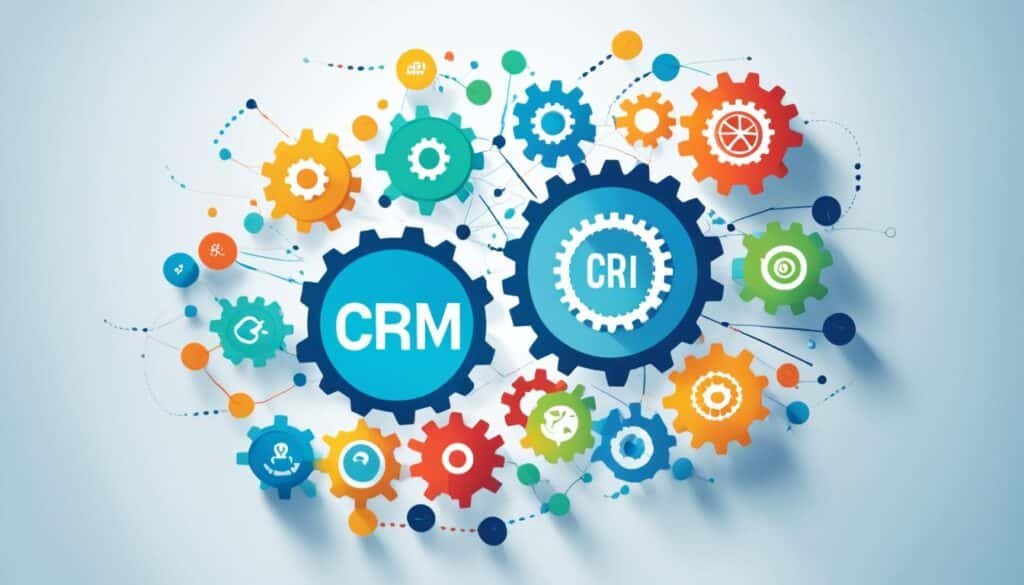E-commerce platforms have become vital for the success of both small- and medium-sized businesses as well as larger enterprises. In the fast-paced digital world, it is crucial for modern enterprises to effectively manage their online stores and fuel business growth through the right e-commerce solutions. The key lies in finding a platform that can scale along with their business and meet their complex requirements.
In recent years, there has been a significant increase in the buying activity of enterprise-level companies. This highlights the importance of choosing the right e-commerce platform that not only caters to their immediate needs but also has the capability to grow with their future sales volumes. It should offer advanced customization options and functionalities that enable businesses to streamline operations and optimize customer experiences.
Key Takeaways: E-commerce Solutions
- E-commerce platforms are essential for modern enterprises to effectively manage their online stores and drive business growth.
- Choosing the right e-commerce platform is crucial for meeting complex requirements and ensuring scalability.
- The platform should offer advanced customization options and functionalities to streamline operations and optimize customer experiences.
- Enterprise-level companies should consider a platform that can scale with future sales volumes and meet their long-term business goals.
- The right e-commerce solution can help modern enterprises thrive in the competitive online retail market.
The Importance of Choosing the Right E-commerce Platform
Choosing the right e-commerce platform is crucial for enterprise businesses. When selecting a platform, it’s important to consider advanced customization options and functionalities that can meet the specific needs of your business.
An ideal e-commerce platform should provide comprehensive marketing analytics to help you understand your customers’ behavior and optimize your marketing strategies. It should also offer robust inventory and order management capabilities to streamline your operations, from tracking stock levels in real-time to efficient order processing and fulfillment.
Resource planning and accounting features are also key elements to look for in an e-commerce platform. These features enable you to manage your resources effectively and gain valuable insights into your financial performance. Additionally, a platform should offer detailed reporting functionalities, allowing you to monitor your sales, revenue, and other important business metrics.
One of the critical factors to consider when choosing an e-commerce platform is the ability to handle your current business needs and scale with your future growth. Your chosen platform should have the flexibility and scalability to accommodate increasing sales volumes and to support your business as it expands.
During the platform selection process, involving multiple departments within your organization is crucial. It helps to gather input from marketing, sales, operations, finance, and IT teams to determine the key requirements and priorities for your platform. Issuing an ecommerce RFP (Request for Proposal) can also be beneficial in soliciting proposals and comparing different platform offerings.
Choosing the right e-commerce platform is a strategic decision that can greatly impact your business. Take the time to evaluate your options and find a platform that aligns with your business goals, supports your operations, and enables you to deliver a seamless shopping experience for your customers.
Key Considerations for Choosing an E-commerce Platform:
- Advanced customization options
- Marketing analytics
- Inventory and order management
- Resource planning and accounting features
- Robust reporting functionalities
- Scalability and growth potential
“Choosing the right e-commerce platform is a strategic decision that can greatly impact your business.”
Factors to Consider Before Replatforming
Replatforming is a critical decision for enterprise businesses seeking to improve their online presence and streamline their operations. However, before embarking on the replatforming journey, there are several factors that need to be carefully considered. By evaluating these factors, businesses can ensure a successful migration to a new e-commerce platform that aligns with their goals and requirements.
1. Define Business Objectives and Pain Points
Before replatforming, it is essential to clearly define the main business objectives for migrating to a new platform. This involves identifying pain points and limitations with the current e-commerce solution. By understanding the shortcomings of the existing platform, businesses can prioritize the features and functionalities they need in the new platform to address these pain points and achieve their objectives.
2. Evaluate Critical Existing Ecommerce Features and Integrations
An important consideration before replatforming is to evaluate and assess the critical features and integrations that are essential to the business’s current e-commerce operations. This includes inventory management, order fulfillment, payment gateway integration, and any other integrations that are vital for seamless business operations. By understanding these requirements, businesses can ensure that the new platform can effectively handle these existing features and integrations.
3. Consider Future Systems Integrations for Phase Two
While evaluating the new e-commerce platform, it is important to consider future systems integrations that may be required for phase two of the business’s growth. This includes integrating with third-party applications, marketing automation tools, customer relationship management (CRM) systems, and other software solutions that will be critical for the business’s future expansion plans. Anticipating these integration needs can help businesses select a platform that is flexible and scalable for future requirements.
“By evaluating these factors, businesses can ensure a successful migration to a new e-commerce platform that aligns with their goals and requirements.”
Replatforming is a complex process that requires careful planning and consideration of various factors. By defining business objectives and pain points, evaluating critical existing e-commerce features and integrations, and considering future systems integrations, businesses can make an informed decision when selecting a new e-commerce platform. Taking these factors into account will help ensure a smooth transition and enable businesses to unlock the full potential of their online operations.
“By evaluating these factors, businesses can ensure a successful migration to a new e-commerce platform that aligns with their goals and requirements.”
Continue reading to learn about the different types of enterprise e-commerce solutions available and how they can impact business operations.
Types of Enterprise Ecommerce Solutions Available

When it comes to choosing an ecommerce platform for your enterprise, there are different types of solutions to consider. Understanding these options can help you make an informed decision based on your specific requirements. The two main types of enterprise ecommerce solutions available are SaaS (software as a service) platforms and headless platforms.
SaaS Platforms
SaaS platforms are cloud-hosted by third-party providers, offering a scalable and easy-to-use solution for enterprise businesses. These platforms provide a complete package of ecommerce features and functionalities, eliminating the need for extensive IT infrastructure or technical expertise. With a SaaS platform, you can quickly set up an online store, customize its design, and manage inventory, orders, and customer data efficiently.
One of the key advantages of SaaS platforms is their scalability. As your business grows, the platform can easily accommodate increased traffic and sales volumes without any disruption. Updates and maintenance are also handled by the provider, ensuring that your online store stays up-to-date with the latest security patches and feature enhancements.
Headless Platforms
Headless platforms, on the other hand, offer more flexibility and customization options for businesses with specific needs. With a headless architecture, the front-end (or “head”) of the website is decoupled from the backend infrastructure, allowing businesses to create unique and tailored customer experiences.
With a headless platform, you have the freedom to choose different technologies and frameworks for your front-end, such as JavaScript, React, or Angular, while still integrating seamlessly with the backend. This flexibility enables businesses to create highly personalized and engaging user interfaces, leverage emerging technologies like progressive web apps (PWAs), and deliver consistent experiences across multiple channels.
However, it’s important to note that headless platforms may require more technical expertise and development resources compared to SaaS platforms. They offer greater customization possibilities but require additional investments in development and maintenance.
Comparing SaaS and Headless Platforms
Here’s a comparison table highlighting the key differences between SaaS and headless ecommerce platforms:
| SaaS Platforms | Headless Platforms |
|---|---|
| Easy to set up and use | Offers more flexibility and customization options |
| Scalable to accommodate business growth | Enables unique and tailored customer experiences |
| Out-of-the-box ecommerce features | Requires more technical expertise |
| Managed updates and maintenance | Custom front-end development |
Ultimately, the choice between a SaaS platform and a headless platform depends on your business requirements, technical resources, and long-term goals. Assessing the scalability, customization options, and development resources available will help you select the right enterprise ecommerce solution for your business.
The Benefits of Ecommerce Integration in Streamlining Business Operations

Ecommerce integration plays a pivotal role in streamlining business operations, enabling companies to optimize their processes and achieve maximum efficiency. By seamlessly connecting various business systems and technology applications, ecommerce integration ensures a smooth flow of data and enables real-time information synchronization across multiple channels.
Integration brings forth a wide range of benefits for businesses, helping them automate processes, minimize errors, and enhance overall accuracy. By eliminating manual data entry and promoting automation, ecommerce integration reduces the risk of human error and enhances the speed and efficiency of operations.
Furthermore, ecommerce integration allows businesses to maintain up-to-date information across all channels. Whether it’s inventory levels, customer data, or sales transactions, integration ensures that all relevant systems are synchronized and reflect the most recent data, enabling businesses to make informed decisions based on accurate information.
One of the key advantages of ecommerce integration is its ability to enhance the customer experience. By streamlining operations and ensuring consistent and reliable service, integration helps businesses deliver a seamless shopping experience to their customers. Customers can enjoy a hassle-free shopping process, with accurate product information, real-time inventory availability, and smooth order processing.
Moreover, ecommerce integration enables businesses to gain a comprehensive view of their operations, bringing together various systems and data sources into a unified platform. This holistic view allows businesses to analyze and monitor their performance, identify areas for improvement, and make data-driven decisions to drive growth and success.
“Ecommerce integration streamlines business processes, improves efficiency, and enhances the customer experience. By seamlessly connecting various systems and technology applications, businesses can automate processes, minimize errors, and ensure accurate data across all channels.”*
To illustrate the impact of ecommerce integration, consider the following example:
| Benefits of Ecommerce Integration | Description |
|---|---|
| 1. Increased Efficiency | Ecommerce integration automates processes, reducing manual effort and increasing operational efficiency. |
| 2. Real-time Inventory Management | Integration ensures accurate and up-to-date inventory information, preventing overselling or stockouts. |
| 3. Seamless Order Processing | Integration streamlines the order fulfillment process, facilitating timely and accurate shipment of products. |
| 4. Enhanced Customer Experience | Integration provides customers with consistent and reliable service, resulting in a seamless shopping experience. |
| 5. Comprehensive View of Operations | Integration brings together various systems into a unified platform, enabling businesses to gain insights and make data-driven decisions. |
Ecommerce integration is a powerful tool that can revolutionize the way businesses operate in the digital landscape. By bridging the gap between different systems and technology applications, integration optimizes processes, improves accuracy, and enhances the overall customer experience. Businesses that embrace ecommerce integration can streamline their operations, drive growth, and stay ahead in the competitive ecommerce market.
*Quote: SEO-friendly quote highlighting the benefits of ecommerce integration.
The Role of CRM and ERP Integration in Ecommerce

The success of an ecommerce business relies heavily on the effective management of customer data, streamlining operations, and optimizing the customer journey. This is where the integration of Customer Relationship Management (CRM) and Enterprise Resource Planning (ERP) systems with ecommerce platforms plays a crucial role.
CRM integration allows businesses to gain valuable insights into customer behaviors, preferences, and purchase history. By efficiently managing and utilizing customer data, businesses can personalize the customer experience, deliver targeted marketing campaigns, and foster long-term customer loyalty. This integration enables enhanced customer segmentation, lead management, and customer support, ensuring an exceptional customer journey.
On the other hand, ERP integration bridges the gap between ecommerce systems and backend operations. By integrating ERP systems with the ecommerce platform, businesses can achieve seamless data flow and functionality across various business segments. This integration ensures accurate inventory management, streamlined order processing, and efficient resource planning.
When CRM and ERP systems are seamlessly integrated with an ecommerce platform, businesses gain a holistic view of their operations, enabling them to make data-driven decisions, identify trends, and improve overall business performance. With a comprehensive understanding of customer behaviors and streamlined backend operations, businesses can effectively meet customer demands, optimize inventory levels, and enhance business efficiency.
“CRM integration provides valuable insights into customer behaviors and preferences, while ERP integration helps bridge ecommerce systems with backend operations, improving data flow and functionality across various business segments.”
Integrating CRM and ERP systems with an ecommerce platform is not only about optimizing internal operations but also about delivering a seamless and personalized customer experience. By leveraging valuable customer data and streamlining backend processes, businesses can build strong customer relationships, drive sales, and gain a competitive edge in the ecommerce industry.
Next, let’s take a closer look at inventory and order management in ecommerce, and how it contributes to the overall success of an online retail business.
Inventory and Order Management in Ecommerce

Effective inventory and order management are crucial components of successful ecommerce operations. Implementing robust inventory management systems allows businesses to track and control stock levels in real-time, preventing overselling or stockouts. By providing accurate inventory information, businesses can avoid disappointing customers by ensuring the availability of products they desire.
Order management systems streamline the entire order processing and fulfillment process, ensuring that every order is promptly and accurately shipped. This helps businesses meet customer expectations for timely delivery and enhance their overall shopping experience. Efficient coordination between inventory and order management operations allows businesses to maintain optimal inventory levels, minimize storage costs, and deliver a seamless customer experience.
Benefits of Inventory Management in Ecommerce
Implementing effective inventory management practices in ecommerce offers several key benefits:
- Accurate Stock Control: With inventory management systems, businesses can track stock levels in real-time, ensuring accurate and up-to-date information about product availability.
- Prevent Overselling: By closely monitoring inventory levels, businesses can avoid overselling products that are out of stock, minimizing customer frustration and negative feedback.
- Prevent Stockouts: Inventory management systems help businesses identify when stock levels are running low, allowing them to replenish inventory before running out, reducing the risk of stockouts.
- Improve Order Fulfillment: With accurate inventory information, businesses can process orders more efficiently and accurately, ensuring prompt shipment and reducing order fulfillment errors.
- Optimize Storage Costs: By efficiently managing inventory levels, businesses can avoid overstocking or understocking, minimizing storage costs and maximizing their return on investment.
Benefits of Order Management in Ecommerce
Implementing effective order management processes and systems in ecommerce offers several key benefits:
- Timely Order Processing: Order management systems automate and streamline the order processing workflow, ensuring that orders are promptly received, verified, and forwarded for fulfillment.
- Prompt Shipment: By integrating order management systems with shipping providers, businesses can ensure that orders are packaged, labeled, and dispatched in a timely manner, reducing shipping delays and improving customer satisfaction.
- Reduced Errors: Order management systems help minimize errors in order processing, ensuring accurate customer information, product selection, and shipping details, reducing the risk of incorrect shipments or returns.
- Enhanced Customer Experience: By delivering prompt, accurate, and well-packaged orders, businesses can enhance the overall shopping experience, fostering customer loyalty and positive reviews.
- Performance Insights: Order management systems provide valuable metrics and analytics, allowing businesses to gain insights into order volumes, popular products, and customer behavior, helping them make strategic decisions to optimize their operations.
Integration between Inventory Management and Order Management
Ensuring efficient coordination between inventory management and order management is crucial for ecommerce businesses. By integrating these two systems, businesses can have real-time visibility into inventory levels, enabling accurate order processing, and preventing stockouts. The integration allows businesses to fulfill orders faster and streamline operations, ensuring a seamless experience for customers.
“Effective inventory and order management are the backbone of successful ecommerce operations. By implementing robust systems and integrating them, businesses can improve customer satisfaction, reduce costs, and achieve sustainable growth.”
To illustrate the importance of inventory and order management in ecommerce, consider the following example:
| Scenario | Impact |
|---|---|
| Sudden Increase in Demand | If inventory management systems are not in place, businesses might face stockouts and be unable to fulfill customer orders, leading to lost sales and damaged customer relationships. |
| Inaccurate Inventory Information | Without effective inventory management, businesses may struggle to accurately track available stock, resulting in overselling or underselling products. This can lead to dissatisfied customers, negative reviews, and potential loss of future sales. |
| Poor Order Processing and Fulfillment | Inefficient order management processes can lead to delayed shipments, incorrect items, and inaccurate tracking information. This negatively impacts the customer experience and can result in returns, refunds, or customer churn. |
| Costly Storage Inefficiencies | Without effective inventory management, businesses may face storage inefficiencies such as overstocking or understocking, leading to increased storage costs and reduced profitability. |
By implementing robust inventory and order management systems, businesses can avoid these challenges and optimize their ecommerce operations, ensuring customer satisfaction, streamlined processes, and sustainable growth.
Expanding Product Mix through Ecommerce Solutions

Expanding the product mix is essential for businesses looking to increase sales opportunities and revenue. With the help of ecommerce solutions, companies can diversify their offerings and tap into new markets. One effective way to expand the product range without the burden of inventory management is by partnering with third-party sellers and utilizing online marketplaces.
By leveraging ecommerce marketplace management systems, businesses can connect with sellers, form dropship partnerships, and provide customers with a diverse range of products. This not only expands the available options for consumers but also allows businesses to tap into the expertise and resources of other sellers. It’s a win-win situation that drives growth and customer satisfaction.
“Expanding the product mix through ecommerce solutions opens up new avenues for businesses to generate revenue and reach a wider customer base. It provides an opportunity to offer complementary products or services alongside their core offerings, catering to the evolving needs and preferences of their target audience.”
Integrating ecommerce solutions and expanding the product mix not only increases sales opportunities but also helps businesses stay competitive in the ever-changing market. It allows companies to adapt to consumer demands, experiment with new product lines, and explore different markets—all without the limitations of traditional brick-and-mortar retail.
Benefits of Expanding the Product Mix:
- Diversify revenue streams
- Attract new customers
- Enhance customer loyalty
- Stay ahead of competitors
- Explore new markets and niches
Expanding the product mix through ecommerce solutions is a strategic move that contributes to the long-term success of a business. By broadening the range of products and services available to customers, companies can unlock new growth opportunities and build a stronger brand presence in the market.
| Benefits of Expanding Product Mix | Examples |
|---|---|
| Diversify revenue streams | Adding new product categories, introducing subscription services |
| Attract new customers | Offering unique products not available elsewhere, targeting niche markets |
| Enhance customer loyalty | Providing a comprehensive selection of products, offering exclusive deals for returning customers |
| Stay ahead of competitors | Introducing innovative products that address emerging trends, anticipating customer needs |
| Explore new markets and niches | Expanding into international markets, targeting specific demographic segments |
Creating an Omnichannel Shopping Experience with Ecommerce Systems

Creating an omnichannel shopping experience is crucial for businesses to meet customer expectations. A fully integrated ecommerce platform that unifies all sales channels into one system can provide a seamless shopping experience for customers, allowing them to interact with the brand across various touchpoints. This includes checking out products on social media, adding items to the cart on the website or mobile app, and trying the product in-store before making a final purchase.
Achieving an omnichannel shopping experience requires an ecommerce system that seamlessly connects different sales channels and makes data accessible across all touchpoints. This integration allows customers to start their shopping journey on one channel and seamlessly transition to another without losing any information. For example, a customer can add products to their cart on their mobile device and later access the same cart from their laptop to complete the purchase.
An omnichannel ecommerce system enables businesses to deliver personalized experiences to customers, as it provides a holistic view of their preferences and behaviors across all channels. This data can be used to tailor product recommendations, promotions, and marketing messages to each individual customer’s preferences, helping to drive customer satisfaction and increase sales.
Furthermore, an omnichannel ecommerce system allows businesses to offer flexible fulfillment options, such as buy online, pick up in-store (BOPIS), or ship from store. This capability provides customers with the convenience of choosing the most convenient fulfillment method for their needs and enhances their overall shopping experience.
By creating an omnichannel shopping experience with a robust ecommerce system, businesses can effectively engage customers, increase conversions, and build long-term loyalty. Embracing this approach allows businesses to stay ahead in the ever-evolving ecommerce landscape and meet the expectations of modern consumers.
Benefits of Creating an Omnichannel Shopping Experience:
- Seamless shopping experience across all channels
- Improved customer satisfaction and loyalty
- Personalized product recommendations and promotions
- Flexible fulfillment options
- Increased conversions and sales
Reducing Total Cost of Ownership with Streamlined Ecommerce Solutions
In today’s competitive business landscape, it is essential for enterprises to find ways to reduce costs and maximize profitability. One effective strategy is to implement streamlined ecommerce solutions that help streamline operations and optimize efficiency. By harnessing the power of integrated platforms, businesses can significantly lower their total cost of ownership while achieving sustainable growth.
The Benefits of Streamlined Ecommerce Solutions
Streamlined ecommerce solutions offer a myriad of benefits that directly contribute to reducing the total cost of ownership. By consolidating various business functions onto a single platform, enterprises can eliminate the need for multiple software applications, resulting in significant cost savings. This integrated approach enables seamless communication and data flow between departments, minimizing errors, and improving operational efficiency.
“Streamlined ecommerce solutions empower businesses to simplify their IT infrastructure and reduce overhead costs by centralizing critical processes on a single platform. This integration not only saves money but also increases productivity and improves customer satisfaction.”
Additionally, streamlined ecommerce solutions provide advanced features such as inventory management, order fulfillment, customer relationship management (CRM), and marketing automation. Having these functionalities integrated into a single platform eliminates the need for separate third-party applications, further reducing expenses.
Optimizing Operations for Cost Reduction
A streamlined ecommerce solution enables businesses to optimize their operations and drive cost reductions across various areas. By automating manual processes and reducing human error, enterprises can achieve greater efficiency and productivity. This results in faster order processing, improved inventory management, and reduced fulfillment costs.
Furthermore, integrated platforms offer robust analytics and reporting capabilities, allowing businesses to monitor and measure key performance indicators (KPIs) in real-time. This data-driven approach enables informed decision-making, helping identify areas for further improvement and cost reduction.
Continuous Growth and Scalability
Streamlined ecommerce solutions are designed to accommodate the evolving needs of modern enterprises. These platforms ensure scalability, enabling businesses to expand their operations effortlessly as their customer base grows. By eliminating the need for costly infrastructure updates or extensive IT support, enterprises can allocate resources towards revenue-generating activities, fueling growth and profitability.
The Benefits of VTEX Commerce Platform for Streamlining Business Operations

In the increasingly competitive world of e-commerce, streamlining business operations is essential for modern enterprises. The VTEX Commerce Platform offers a range of benefits that can help businesses optimize their processes and achieve success.
By leveraging the VTEX Commerce Platform, businesses can increase their productivity and reduce inefficiency costs. The platform provides a fully integrated system for all business functions, eliminating the need for multiple applications and simplifying operations. This streamlines workflows and allows businesses to focus on what they do best.
“The VTEX Commerce Platform has revolutionized our business operations. It provides a seamless experience for our customers and improves our internal efficiency. The integration of multiple systems into one platform has been a game-changer for us.”
In addition to streamlining operations, the VTEX Commerce Platform also eliminates costly integration problems. With its built-in ecommerce marketplace management system, businesses can easily expand their product mix by connecting with third-party sellers and offering a wider range of products. This opens up new sales opportunities and drives revenue growth.
The VTEX Commerce Platform also empowers businesses to create an omnichannel shopping experience for their customers. By unifying all sales channels into one system, businesses can provide a seamless shopping experience, allowing customers to interact with the brand across multiple touchpoints. Whether it’s browsing products on social media, adding items to the cart on the website or mobile app, or trying the product in-store, the VTEX Commerce Platform ensures a consistent and convenient experience for customers.
Furthermore, adopting the VTEX Commerce Platform reduces the total cost of ownership for businesses. By optimizing operations and eliminating the need for multiple software applications, businesses can lower their overhead costs while increasing their revenue and profitability. This allows enterprises to allocate their resources more efficiently and invest in further growth and expansion.
In conclusion, the VTEX Commerce Platform offers a comprehensive solution for modern enterprises looking to streamline their business operations. From increasing productivity and eliminating inefficiency costs to expanding product mix and providing an omnichannel shopping experience, the platform empowers businesses to thrive in the competitive e-commerce landscape. By choosing the VTEX Commerce Platform, enterprises can unlock their full potential and achieve long-term success.
Best eCommerce platform for adding a shopping cart to an existing WordPress site
Here are 10 options for the best eCommerce platforms to add a shopping cart to an existing WordPress site:
- WooCommerce: Highly customizable and seamlessly integrates with WordPress.
- Shopify: Offers a WordPress plugin for easy integration and robust eCommerce features.
- BigCommerce: Provides a WordPress plugin for integrating its powerful eCommerce platform.
- Ecwid: Allows you to add a shopping cart to any existing website, including WordPress.
- Magento: Offers a WordPress extension for integrating its advanced eCommerce functionality.
- Easy Digital Downloads (EDD): Ideal for selling digital products and integrates well with WordPress.
- WP eCommerce: A WordPress plugin that enables you to add eCommerce functionality to your site.
- Selz: Offers a WordPress plugin for adding a shopping cart to your existing site.
- Squarespace: While not specifically for WordPress, Squarespace provides easy eCommerce integration.
- 3dcart: Offers a WordPress plugin for integrating its comprehensive eCommerce platform.
Best free eCommerce website building platform
One of the best free eCommerce website building platforms is WooCommerce. As a WordPress plugin, WooCommerce seamlessly integrates with your existing WordPress site, providing robust eCommerce functionality without any additional cost. It offers a wide range of features, including customizable designs, secure payment options, inventory management, and marketing tools. Another excellent option is Shopify’s Lite plan, which allows you to add a “Buy” button to your existing website or social media profiles, enabling easy selling of products without the need for a full-fledged eCommerce website. Both WooCommerce and Shopify Lite offer powerful features for building an online store at no initial cost.
What is ecommerce software?
E-commerce software refers to specialized applications or platforms designed to facilitate online transactions, sales, and management of an online store. It provides essential features such as product catalog management, shopping cart functionality, payment processing, order fulfillment, and often includes tools for inventory management, marketing, and customer relationship management (CRM). E-commerce software can vary widely in complexity and features, ranging from simple plugins like WooCommerce for WordPress to comprehensive platforms like Shopify or Magento. Its primary purpose is to enable businesses to create and manage an online presence, sell products or services, and streamline the e-commerce process.
Start selling online with Shopify
Start selling online with Shopify, a leading e-commerce platform trusted by millions of businesses worldwide. With Shopify, you can easily create a professional online store without any coding knowledge. Choose from a wide range of customizable templates, manage your products and inventory effortlessly, and accept secure payments from customers around the globe. Shopify offers powerful marketing tools to attract and engage customers, along with built-in analytics to track your sales and performance. Whether you’re just starting out or looking to expand your online presence, Shopify provides everything you need to build, grow, and succeed in e-commerce.
The 6 best eCommerce website builders
Discover the top 6 eCommerce website builders for creating stunning online stores. Shopify leads the pack with its user-friendly interface and comprehensive features. WooCommerce, a WordPress plugin, offers flexibility and customization options. BigCommerce impresses with its scalability and built-in marketing tools. Wix eCommerce combines drag-and-drop simplicity with powerful eCommerce functionality. Squarespace boasts elegant templates and integrated marketing tools. Magento, though more complex, provides unparalleled customization for larger enterprises. Each of these platforms caters to different needs and preferences, offering a range of features to help businesses of all sizes succeed in the competitive world of online retail.
Aligning business needs with an ecommerce platform
Aligning business needs with an eCommerce platform is crucial for success in the online marketplace. Understanding your business goals, target audience, and product offerings is the first step. Consider factors such as scalability, customization options, ease of use, and integration capabilities when selecting a platform. Assess the platform’s features and functionality to ensure they meet your specific requirements, whether it’s inventory management, payment processing, or marketing tools. Additionally, evaluate the platform’s pricing structure and support services to ensure it aligns with your budget and level of expertise. By choosing the right eCommerce platform, businesses can effectively meet their objectives and thrive in the digital landscape.
Also Read: Exploring The Future Of E Commerce Trends And Growth
Conclusion
Streamlining business operations with the right e-commerce solutions is crucial for modern enterprises. By choosing the right platform, integrating systems effectively, and optimizing inventory and order management, businesses can achieve growth and success in the competitive online retail market.
The VTEX Commerce Platform offers a comprehensive solution for streamlining business operations. With its advanced customization options and functionalities, businesses can increase productivity, reduce costs, and deliver a seamless customer experience. The platform’s integration capabilities and omnichannel support enable businesses to connect with customers across multiple touchpoints, enhancing brand engagement and loyalty.
By leveraging e-commerce solutions, businesses can streamline their operations, strengthen their competitive edge, and drive sustainable growth. The VTEX Commerce Platform stands out as a trusted partner, empowering modern enterprises to streamline their business processes, deliver exceptional customer experiences, and stay ahead in the dynamic world of online retail.
FAQs
Q: What are the best e-commerce platforms to consider for modern enterprises?
A: Some of the best e-commerce platforms to consider include Shopify, WooCommerce, BigCommerce, and WordPress with plugins like WooCommerce or Shopify integration.
Q: How can an online store benefit a small business?
A: An online store can benefit a small business by expanding its reach to a global audience, increasing sales opportunities, and providing a convenient platform for customers to browse and purchase products.
Q: What should businesses look for in an e-commerce solution?
A: Businesses should look for features such as easy website building, secure payment processing, reliable customer support, SEO optimization tools, and scalability to meet their growing business needs.
Q: What are the key factors to consider when choosing the best e-commerce platform?
A: When choosing the best e-commerce platform, consider factors such as pricing, ease of use, available templates, integration options, e-commerce features, scalability, and customer support options.
Q: How can an e-commerce website builder help in creating an online business?
A: An e-commerce website builder can help in creating an online business by providing easy-to-use tools for building a professional-looking website, setting up an online store, managing products, and processing payments.
Q: Which e-commerce platform is recommended for small businesses to sell online?
A: Shopify is a popular choice for small businesses looking to sell online due to its user-friendly interface, customizable options, integrated payment processing, and reliable customer support.
Q: What are the advantages of using WordPress for e-commerce solutions?
A: WordPress offers flexibility, scalability, a wide range of plugins for e-commerce functionality, SEO optimization capabilities, and the ability to create a unique online store tailored to specific business needs.
Q: How can businesses ensure the success of their e-commerce platform in 2024?
A: Businesses can ensure the success of their e-commerce platform in 2024 by staying updated on industry trends, implementing user-friendly features, optimizing for mobile devices, focusing on SEO strategies, and providing excellent customer service.




